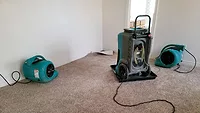The Secret Ingredient for Better Drying: Heat!

Photo Credit: Reets Drying Academy
In the world of water damage restoration, drying that allows you to save more materials and do less demo is key. The more materials you save, the quicker you can move on to the next job, the more profitable you will be—and the happier your clients will be. No doubt you are working to do that right now.
But what if there was a way to supercharge your drying process? Spoiler alert: there is and it’s all about heat.
Using controlled heat during drying isn’t just about speeding up the process; it’s about mitigating interruption for property owners, reducing costs for insurers and making jobs more profitable for restoration companies. Let’s dive into why a little warmth makes a big difference.
The Power of a Little Heat: Why It Works
Evaporation is the process of turning liquid water into vapor so it can be removed from a structure with dehumidifiers.
Heat plays a crucial role in this process. By adding just a bit of warmth to your drying environment, you increase the energy and vapor pressure of water and that helps evaporation. If all other things are equal, more heat means more evaporation.
There is science behind this: vapor pressure differentials. Heat water to increase water vapor pressure. Dry the air to decrease air vapor pressure. The warmer the water and drier the air, the greater the vapor pressure differential (the difference between the vapor pressures of the water and the air) and the greater the evaporation power. Like a truck rolling down a hill, the steeper the hill the greater the force.
If you want to go a little more in-depth, check out this blog article I wrote. Wanna go a LOT more in depth, check out ReetsTV for free and nerd out.
To Think About: Clothes dryers and hair dryers both use the principle of adding heat to water to create evaporation.
Pro Tip: Dealing with a drying challenge? Warm up the wet materials as little as 10℉ by changing the HVAC thermostat, using a temporary heater or IR heat panel or using an air injection system since most of them heat the air they blow out. Don’t get crazy, keep surface temperatures below 95℉ and you will stay safe with most materials.
Saving Materials: A Win for Property Owners and Insurers. And Restorers!
Warm up. Having the additional power to dry materials you may have thrown out otherwise has three big benefits:
- Happier Property Owners: Restoring original materials means less disruption and a faster return to normal for homeowners and businesses.
- Lower Costs for Insurers: Restoration is cheaper than replacement. Saving flooring, drywall and cabinets reduces claim costs significantly.
- More Profitable Jobs: More drying and less demo means fewer expensive labor hours and more profitable equipment rentals, boosting profit margins for restoration companies.
The Formula for Faster, More Effective Drying. And More Happiness.
Hot, Dry Airflow to the Water! This simple phrase is the key to maximizing your drying efficiency. Here’s why it works:
- Hot: Warm air adds energy to water molecules, increasing vapor pressure and making them evaporate faster. Even a small temperature increase can make a big difference.
- Dry: Dry air has lower vapor pressure, encouraging more water to turn into vapor.
- Airflow: Rapid airflow speeds energy transfer from air to water, in turn making evaporation more powerful. Rapid airflow also pushes the hot, dry air into and around the assemblies we are drying.
By combining these elements, you will save more materials—making everyone involved happier. Including you. You will be happier too.
Containment: Focusing the Heat Where It Matters
To get the most out of your heat, you need to control where it goes. Without containment, warm air and moisture spread throughout the building instead of to the materials you are trying to restore. A lack of containment turns into ‘cooking’ the building. NOT where we are going.
There are two types of containment:
- Direct Containment: Placing containment directly on wet surfaces and supplying warm air under the containment or by pushing heat into assemblies. This method powers up drying the most by focusing heat and airflow right where it’s needed.
- Regional Containment: Isolating wet rooms or sections of a building. Smaller contained areas makes it easier to control where the heat is going.
Pro Tip: When using direct containment on hard surfaces, use sand bags to hold down the containment and let heat escape near walls to dry them faster, preventing the need for replacement.
Efficiency and Profitability: The Benefits Heat Up
Let’s connect the dots:
- Less disruption: less materials torn out = less time and mess doing reconstruction.
- Less cost to insurers: less demolition and replacement = lower claim costs for insurers.
- More profit: less demo and more equipment rental = lower costs, higher rentals.
The result? Higher profits for restoration companies and a better overall experience for property owners and insurers. It’s a win-win-win!
Turn Up the Heat, Turn Up the Profits
The next time you’re facing a challenging drying job, remember: a little heat goes a long way. Don’t cook the building, warm wet materials. By adding warmth to your drying process, you can save more materials, reduce costs for insurers, increase your profits—and find a little drying happiness in the process.
So don’t just dry—dry smarter.
Looking for a reprint of this article?
From high-res PDFs to custom plaques, order your copy today!








